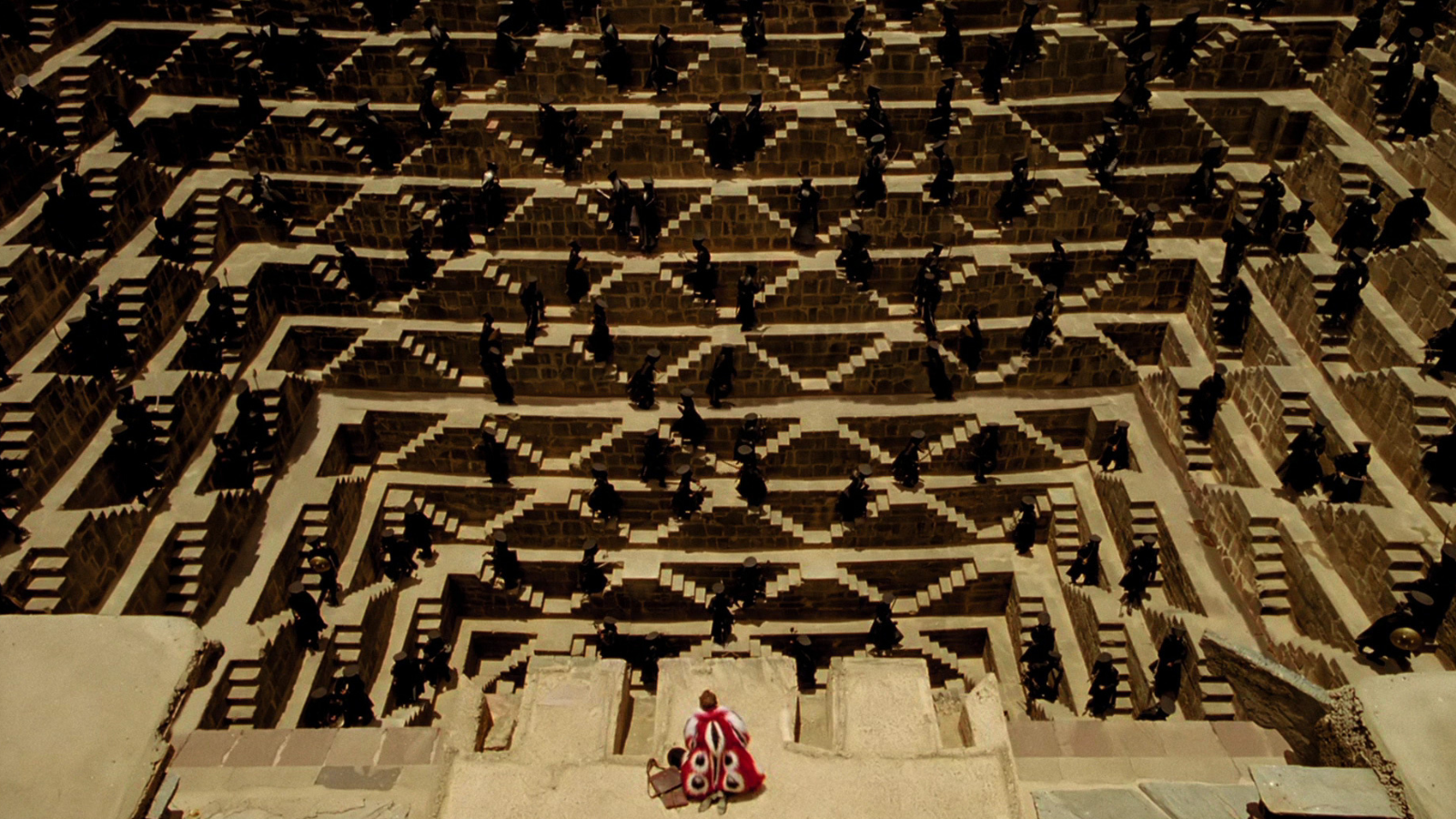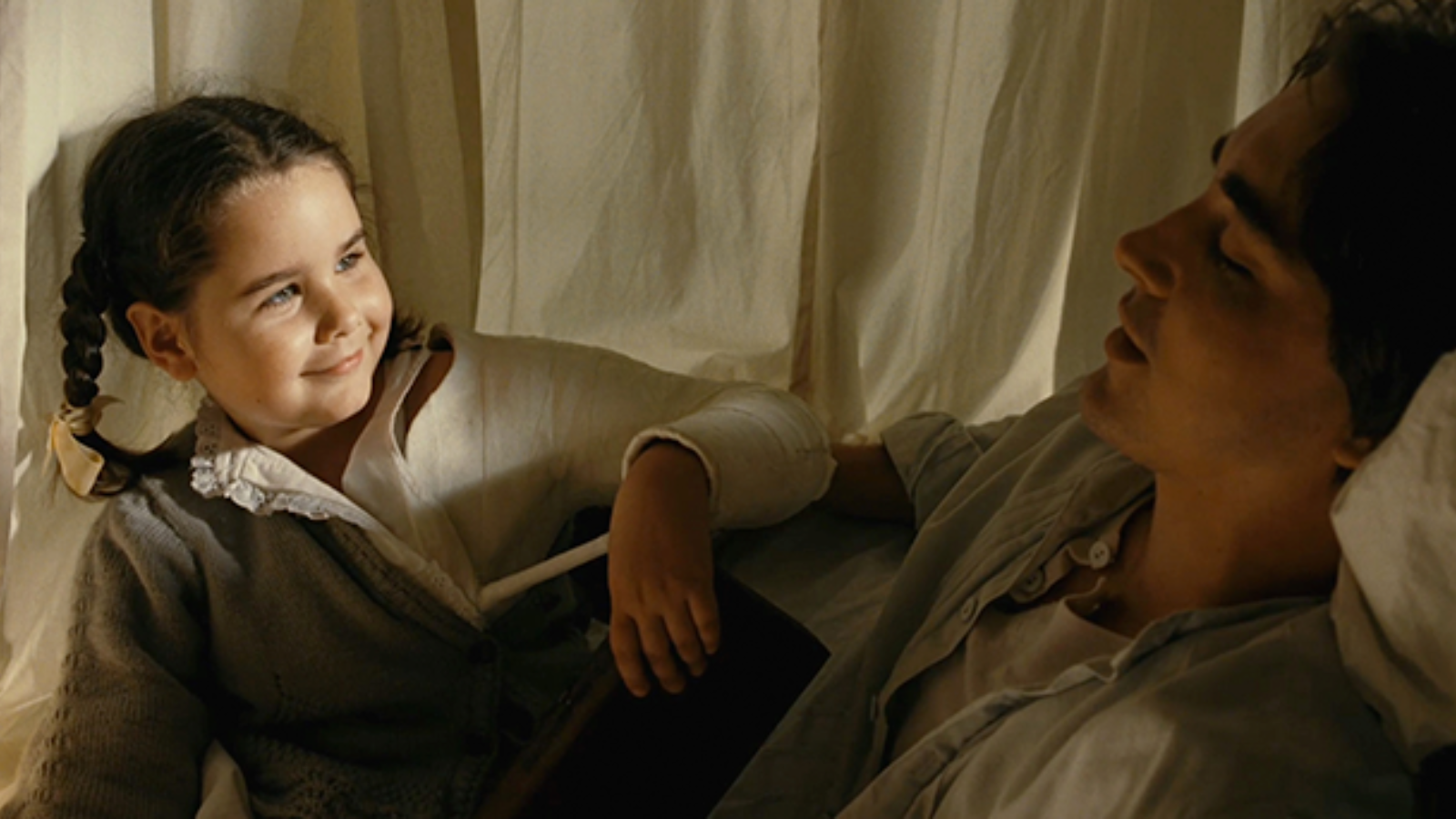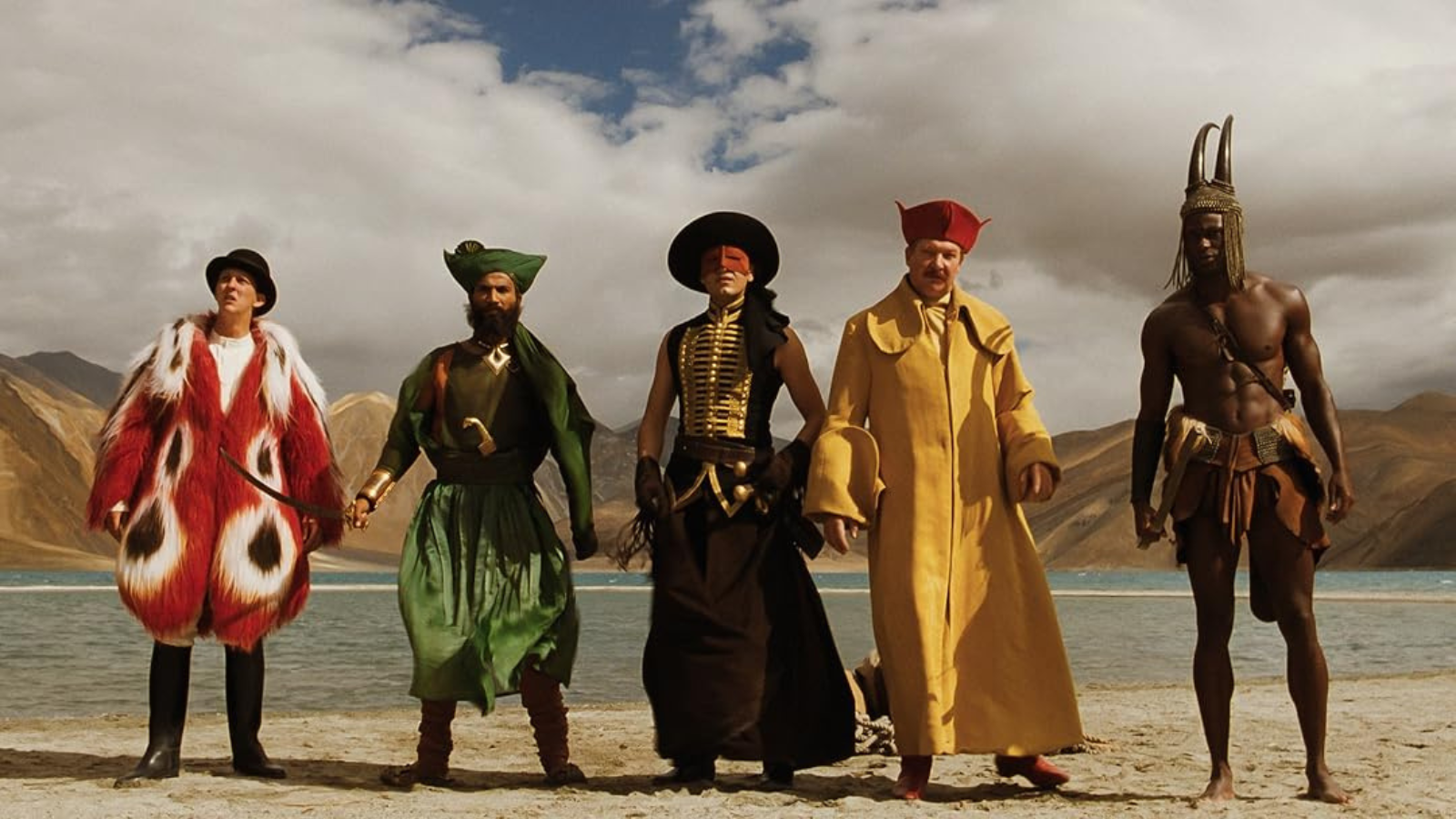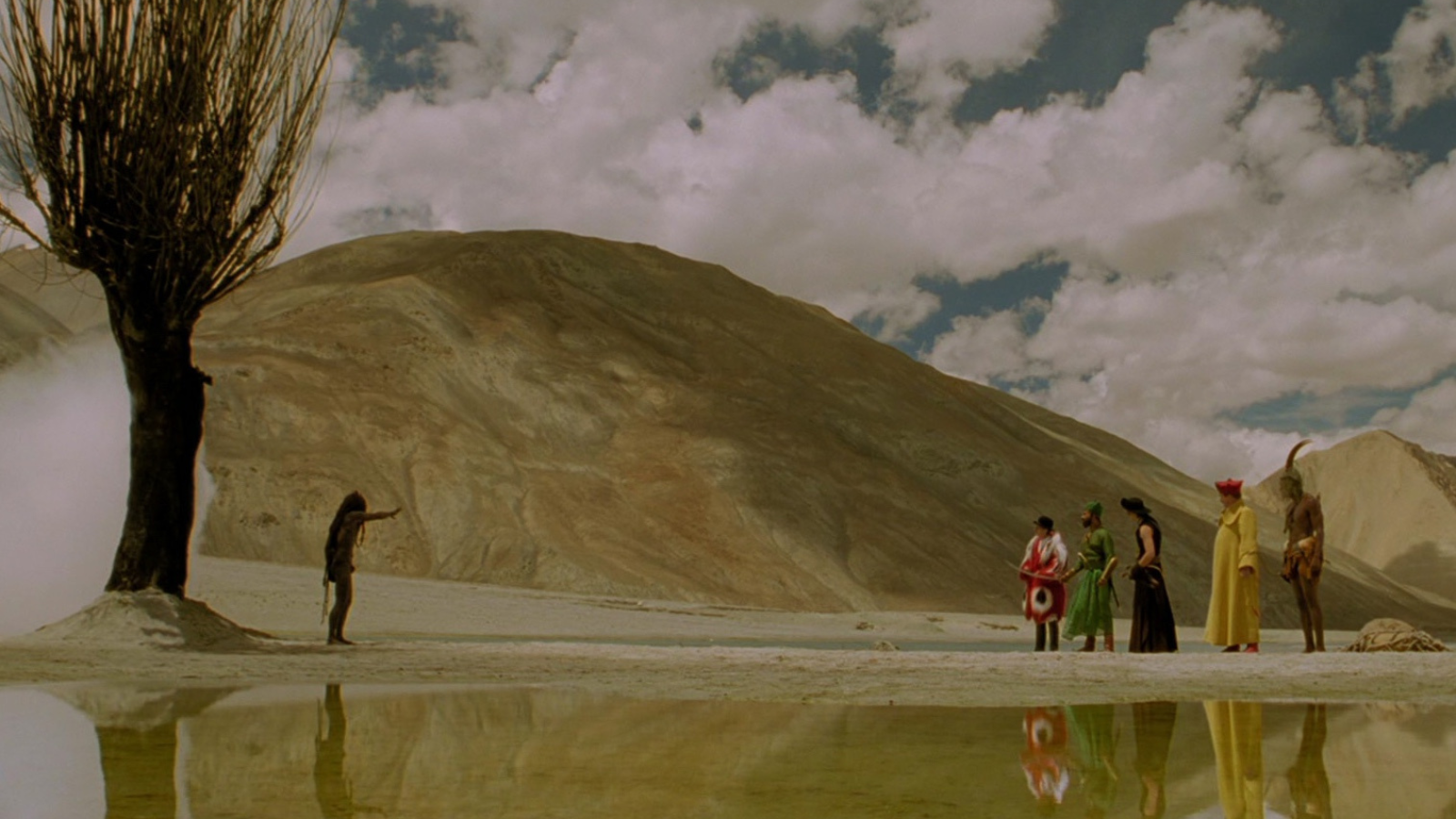Tarsem Singh’s The Fall (2006) is a visually stunning and emotionally charged masterpiece that defies easy categorization. Set in a Los Angeles hospital during the 1920s, the film tells the story of Roy Walker (Lee Pace), a bedridden stuntman who befriends a young immigrant girl, Alexandria (Catinca Untaru), recovering from a broken arm.
Roy weaves an epic tale of five heroes on a quest for revenge against the malevolent Governor Odious, but his story is laced with his own despair and manipulative intentions. As Alexandria’s vivid imagination brings the tale to life, their shared narrative becomes a canvas for exploring trauma, healing, and redemption.
Tarsem Singh, known for his work on The Cell (2000) and his background in directing commercials and music videos, brings his signature visual artistry to The Fall. Shot in over 20 countries without CGI, the film is a visual feast, with each frame carefully crafted to evoke wonder and introspection. Singh’s dedication to authentic, location-based filmmaking gives The Fall a timeless and otherworldly quality that perfectly complements its thematic depth.
From the therapeutic power of storytelling to the resilience of imagination and the film’s surrealist visual language, we’ll uncover how this cinematic odyssey invites viewers to confront their inner worlds and reimagine their realities. Whether you’re a fan of visionary filmmaking or someone seeking inspiration for personal growth, The Fall offers profound insights into the transformative power of narrative and art.
Join us as we step into The Fall’s luminous world and discover its rich parallels to altered states of consciousness, therapeutic practices, and the boundless potential of the human mind.

The Psychedelic Metaphor in The Fall
At its heart, The Fall navigates the porous boundary between reality and fantasy, inviting viewers into a dreamlike realm that mirrors the experience of altered states of consciousness. Tarsem Singh uses this interplay to craft a cinematic language that resonates with those familiar with the psychedelic journey: a place where perceptions shift, emotions surface, and deeper truths are revealed. By juxtaposing Roy’s harsh reality with Alexandria’s whimsical imagination, The Fall becomes a metaphor for the mind’s ability to reframe pain into profound transformation.
Reality and Fantasy: The Bridge Between Worlds
The film’s dual narratives—Roy’s somber hospital stay and the vibrant epic he spins for Alexandria—are parallel realities, each influencing the other. Roy’s storytelling is a means of escaping his despair, but Alexandria’s vivid imagination transforms it into a grand myth, infusing the tale with her innocence and hope.
This interplay echoes the psychedelic experience, where ordinary perceptions dissolve, and the mind creates alternate landscapes to process emotions and traumas. Much like Alexandria’s reinterpretation of Roy’s narrative, altered states invite us to reframe our inner narratives, creating new pathways to healing and understanding. The oscillation between reality and fantasy in The Fall captures this process with stunning emotional clarity.
Governor Odious and the Shadow Self
In Roy’s story, the villainous Governor Odious is far more than an antagonist. He embodies Roy’s shadow self—the amalgamation of his fears, regrets, and hopelessness. This archetype is familiar in myths and psychedelic journeys, where inner exploration often brings unresolved traumas and darker aspects of the self to light.
Odious’s tyranny mirrors Roy’s feelings of entrapment and despair. Yet, as the story evolves, it becomes a battlefield where Roy’s will to survive and Alexandria’s hope begin to challenge the dominance of this shadow, underscoring the transformative power of facing one’s inner demons.
Storytelling as Healing: Lessons from The Fall
At its core, The Fall is a profound exploration of storytelling as a tool for emotional processing and transformation. Tarsem Singh masterfully demonstrates how narrative can bridge the gap between pain and healing, offering a framework for characters—and viewers—to reframe despair into meaning. Roy’s journey through storytelling reflects the profound therapeutic potential of weaving personal experiences into tales of heroism, struggle, and redemption. Meanwhile, Alexandria’s role in reshaping Roy’s story highlights the collaborative nature of healing, where the shared act of creating meaning can alter the trajectory of suffering.
Narrative Therapy in Action
Roy’s fantastical tale is more than escapism—it reflects his inner world. The bleak undertones of his story mirror his depression and despair after he loses his ability to perform stunts and the woman he loves. In narrating this story, Roy externalizes his pain, transforming intangible emotions into characters and conflicts that can be confronted and processed.
This aligns closely with the principles of narrative therapy, a therapeutic approach where individuals re-author their stories to find empowerment and healing. Like in The Fall, this process allows people to distance themselves from their pain, view it from new perspectives, and create narratives that foster growth. Roy’s storytelling, while initially manipulative, becomes a vessel for confronting his despair and reevaluating his purpose.
Alexandria’s Role in Roy’s Redemption
Alexandria’s interpretation of Roy’s story shifts its trajectory, infusing it with innocence, hope, and imagination. Her unwavering belief in the heroes’ triumphs reshapes Roy’s perspective, urging him to consider the possibility of a brighter outcome.
This dynamic underscores the collaborative nature of healing. Roy’s redemption is not achieved in isolation; Alexandria’s input transforms the story from a dirge into a hopeful epic. Her role reflects the communal aspect of storytelling, where connection and shared imagination can catalyze profound emotional breakthroughs.

Imagination as a Path to Resilience
Imagination has long been a sanctuary for the human spirit, where resilience is forged, and possibilities are reimagined. In The Fall, Alexandria’s unyielding imagination is a powerful survival mechanism, enabling her to navigate trauma and reshape her reality. Through her eyes, a sterile hospital becomes a portal to a vibrant, magical epic, demonstrating the transformative potential of creativity in the face of adversity. Her journey invites us to reflect on the role of imagination in spiritual and therapeutic practices, where visualization can catalyze healing and growth.
Alexandria’s World-Building as a Survival Mechanism
For Alexandria, storytelling is more than entertainment—it’s a way to process her fears and find strength. As Roy weaves his tale, Alexandria transforms it into a world reflecting her experiences and dreams. The villain, Governor Odious, embodies the dangers she senses but cannot fully articulate. The hero’s quest mirrors her determination to overcome her fractured arm and the uncertainties of her young life.
This act of world-building is a form of creative visualization, a technique often used in spiritual and therapeutic practices to foster resilience and healing. Visualization, like Alexandria’s storytelling, allows individuals to rehearse success mentally, face fears in a controlled setting, and imagine solutions to challenges. Whether through guided imagery, meditative practices, or the free play of imagination, this process can be deeply empowering. Alexandria’s ability to create meaning from chaos exemplifies the human capacity to find hope in even the darkest circumstances.
The Childlike Lens of Wonder
Alexandria’s perspective is imbued with childlike wonder, transforming every corner of the story into a possibility for beauty and triumph. Her innocence reframes Roy’s despair, countering his nihilistic tendencies and infusing his tale with hope.
This lens of curiosity and hope is a cornerstone of resilience. When we approach challenges with the openness of a child, we unlock pathways to creativity and solutions we might otherwise overlook. Alexandria reminds us that even amidst trauma, the ability to wonder can illuminate new possibilities and inspire us to keep moving forward.
By embracing Alexandria’s example, we can harness imagination as a tool for resilience. We should view life’s adversities not as endings but as opportunities to rewrite the narrative with curiosity, courage, and hope.

Filmmaking as a Psychedelic Experience
Tarsem Singh’s The Fall isn’t just a story—it’s a sensory experience that mirrors a psychedelic journey’s visual and emotional landscapes. Through surrealist aesthetics, vivid imagery, and a non-linear narrative structure, Singh crafts a cinematic language that evokes the fluid, dreamlike quality of altered states of consciousness. The film becomes a kaleidoscope of color, form, and emotion, inviting viewers to step outside linear logic and immerse themselves in a world where perception is as malleable as the mind.
Tarsem Singh’s Visual Language
At the heart of The Fall is its breathtaking visual storytelling, which draws heavily from surrealist art and classical composition. Singh eschews CGI and films in over twenty real-world locations to create a visually authentic yet otherworldly aesthetic. From the grandeur of desert landscapes to the intricacy of ancient architecture, each scene is meticulously crafted to transport viewers into a dreamlike realm.
Vivid colors dominate the screen, with each hue carrying a symbolic weight. The fiery reds of battle scenes evoke intensity and rage, while lush greens and blues bring moments of reflection and healing. This interplay of color parallels the heightened sensory awareness often reported in psychedelic experiences, where ordinary details take on profound significance.
Symmetry and composition further enhance the film’s surreal quality. Singh frequently frames scenes like paintings, meticulously balancing them to draw the eye and mind into the frame. This technique mirrors the heightened sense of interconnectedness experienced during altered states, where patterns and relationships emerge startlingly.
The Power of Non-Linear Narratives
The structure of The Fall mirrors the fluidity of thought and perception found in psychedelic states. The film’s two narratives—the hospital-bound reality and the sprawling epic—interweave seamlessly, influencing each other. The shifts between these worlds feel less like a jump in logic and more like a natural flow of consciousness, reflecting how the mind moves in altered states.
Roy’s storytelling is deliberately fragmented and shaped by his emotions and physical state. This non-linear approach invites the audience to engage actively, piecing together meaning as the story unfolds. It mirrors the introspection of psychedelics, where revelations come in waves, often layered and multifaceted.
By combining surreal visuals with a narrative structure that defies traditional logic, Singh creates a film that isn’t just watched but experienced. The Fall becomes a cinematic journey into the mind, where reality and imagination converge in a profoundly transformative exploration of self and story.

Real-World Parallels and Practices
The Fall’s themes of storytelling and imagination transcend its cinematic framework, finding real-world resonance in therapeutic practices like psychedelic-assisted therapy and mindfulness. These methods, like the film’s narrative, harness the mind’s ability to reframe pain and discover new pathways for healing. By drawing parallels between the fantastical elements of The Fall and these practices, we see how imagination and narrative can guide transformative journeys in the real world.
Storytelling and Psychedelics in Therapy
In psychedelic-assisted therapy, storytelling often becomes a vital tool for processing trauma and integrating insights gained during sessions. Patients in altered states of consciousness frequently encounter symbolic visions and narratives, which therapists help them interpret and weave into their personal stories. Like Roy in The Fall, these individuals externalize their pain and fears, crafting a narrative that allows them to confront, process, and ultimately transform their struggles.
The film’s depiction of Governor Odious as a manifestation of Roy’s inner torment aligns with the experiences many people have during psychedelics, where suppressed emotions take on archetypal or symbolic forms. Through narrative, both in therapy and in the film, these inner conflicts become approachable, empowering individuals to rewrite their relationship with pain and trauma.
Imagination in Mindfulness and Resilience Practices
Alexandria’s imaginative storytelling in The Fall mirrors techniques used in mindfulness and visualization practices. Creative visualization exercises, where individuals imagine themselves succeeding or overcoming challenges, are widely used to build resilience and foster healing. For example, someone navigating grief might imagine their emotions as a river, observing its flow without resistance.
Similarly, guided imagery often employs narratives to evoke safety and self-discovery, much like Alexandria’s reimagining of Roy’s tale transforms fear into hope. These practices cultivate a sense of control and possibility, even in adversity.
By merging imagination and mindfulness, we can, like Alexandria, reframe our realities and discover resilience in the stories we choose to tell ourselves. The Fall serves as a striking reminder of this transformative potential.
Why The Fall Resonates as a Psychedelic Journey
The Fall is more than a film; it’s an odyssey that mirrors the transformative potential of altered states. By weaving together the stark reality of Roy’s despair and the vibrant fantasy of Alexandria’s imagination, Tarsem Singh creates a narrative that reflects the human mind’s ability to reshape pain into profound growth. The film’s exploration of storytelling, shadow work, and resilience parallels the journeys many undertake during psychedelic experiences, where inner worlds unfold, trauma takes symbolic form, and healing begins through reframing and integration.
Through its breathtaking visuals and layered storytelling, The Fall reminds us of the power of imagination to navigate life’s adversities. It invites us to see our struggles as part of a larger narrative—one we have the agency to shape. Like Alexandria, we can use imagination to build worlds of possibility, and like Roy, we can rewrite our darkest chapters into tales of redemption and hope.
Let The Fall inspire you to explore your inner story, embrace your shadow, and harness creativity as a tool for transformation. Its luminous embrace of reality and fantasy offers a profound message: healing begins when we dare to imagine a new way forward.















